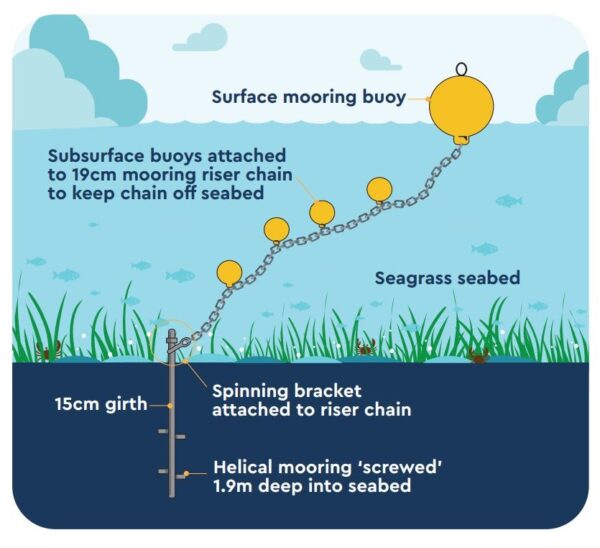Following the installation of an Advanced Mooring System in Cawsand Bay four years ago, in a joint project by the Ocean Conservation Trust and Marine Conservation Society there has been a 212% increase in seagrass cover.
Traditional anchoring and mooring systems cause damage to delicate seagrass habitats, as the chain drags along the seabed disturbing and damaging the plants. These systems also use a heavy concrete sinker block to attach the mooring to the seabed, which leaves a large and damaging footprint.
The Advanced Mooring System allows boats to safely moor, whilst also protecting seagrass. It uses a series of mid-water floats to elevate the chain from the seabed, allowing seagrass to grow, undisturbed.
Image from the Ocean Conservation Trust
The initial project installed five Advanced Mooring Systems in Cawsand Bay in 2019, with a further 12 added in 2021. Cawsand Bay is one of the busiest areas of Plymouth Sound, particularly with tourism and small boat use. This applied conservation effort with the boating community has had significant positive impact on the seagrass meadows here.
Jean Luc-Solandt of the Marine Conservation Society noted that “It’s incredibly rewarding to see the seagrass meadows reappear after the installation of the Advanced Mooring Systems, restoring a vital habitat for local biodiversity, carbon storage and coastal protection. You can’t get restoration without protection, and by working with the local boating community to protect the seabed, we have collectively given space for this rewilding to take place. Against the backdrop of the climate and nature emergency, the success of this simple system shows how pioneering projects can have a mitigating effect on the impacts of climate change, and reverse local biodiversity decline.”
To read the full article from the Ocean Conservation Trust article click here.
To learn more about the Advanced Mooring System click here.
